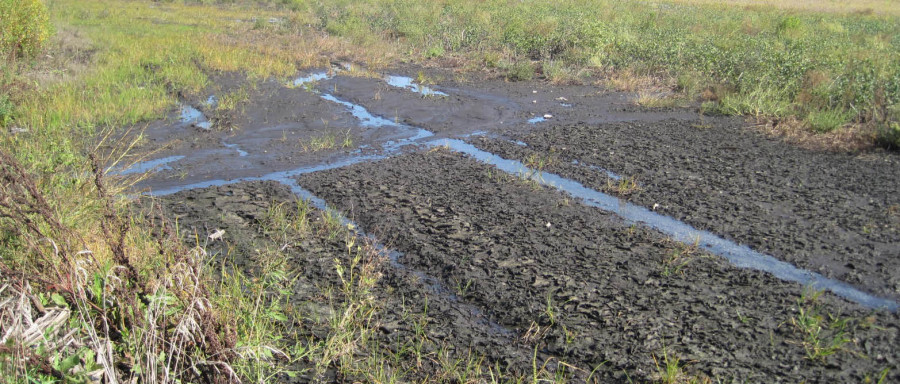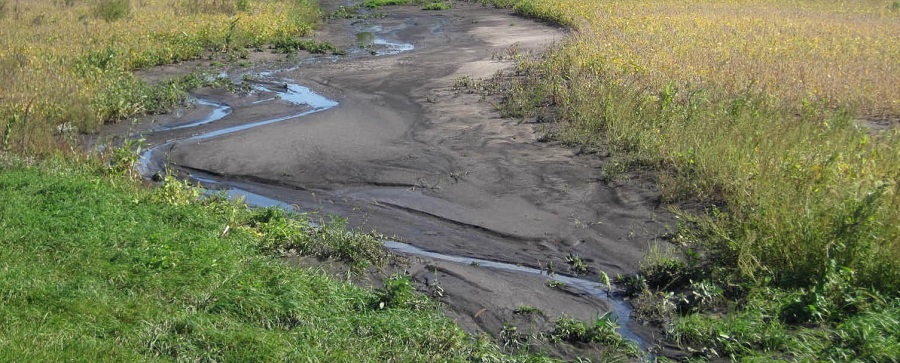
Last week the Iowa Soybean Association released its Water Quality Data Report for 2015. The association monitored water at 45 testing sites along the Raccoon River and its tributaries, taking readings every two weeks during the growing season.
The report called 2015 “an exceptional year for nitrate levels”—meaning exceptionally bad. The soybean group has been collecting data from its 45 sites for more than 10 years.
This year’s data showed 27 locations with the highest average of nitrate concentration ever recorded, and eight sites had the second-highest average of nitrate concentration ever.
Four monitoring sites showed nitrate levels below the 10-milligrams-per-liter (mgm/L) standard considered safe for drinking water by the U.S. Environmental Protection Agency. Two of the safe sites were on Walnut Creek and two on the South Raccoon River.
The highest nitrate level was found on Elk Run Creek in northern Carroll County. This creek had an average reading of 35.4 mgm/L for the 2015 growing season, and in one instance it spiked to 46.8 mgm/L, a very high reading.
Elk Run Creek is reportedly heavily affected by livestock waste. Nitrate can come from manure as well as chemical fertilizer. It enters Iowa’s waterways when irresponsible methods of land use permit soil erosion and nutrient runoff.

The Iowa Soybean Association also tested water in the Boone River Watershed. They found nitrate in lower levels of concentration but still above 10 mgm/L. Nitrate is naturally found in Iowa’s waters but not at the high levels currently recorded.
Historical records indicate before 1910 the nitrate level in the water was 1 mgm/L, and until 1973 the concentration level was around 5 mgm/L. After 1973 the numbers began to climb.
For more than 50 years, medical science has known that a nitrate level of more than 10 mgm/L in drinking water is dangerous to infants, pregnant women and some adults with chronic illness.
Infants who drink water with high nitrate levels can develop a potentially fatal condition called “blue baby syndrome” or methemoglobinemia. The nitrate reacts with the red blood cells and reduces the blood’s ability to carry oxygen, causing the baby’s fingers and lips to turn blue.
There is no known immediate effect on healthy humans who drink water with high levels of nitrate. However, some studies seem to indicate a correlation with certain types of cancers associated with drinking water high in nitrate.
The Des Moines Water Works has special equipment to remove nitrate from the Raccoon River and make it safe to drink.
The Raccoon River Watershed is in 17 Iowa counties, covering 3,600 square miles or 6.4 percent of Iowa’s land area. It carries the highest amount of nutrients of all the rivers in the Mississippi River Basin. The Raccoon River is a major contributor to the hypoxia or “dead zone” in the Gulf of Mexico.
To address these issues, the Iowa Department of Land Stewardship, the Iowa Department of Natural Resources and Iowa State University developed the Nutrient Reduction Strategy—a voluntary plan to reduce nutrient runoff by 45 percent. The plan includes proven agricultural practices to keep nutrients such as nitrate and phosphorus on Iowa’s farm fields and out of the waterways.
The data shows that a lot more needs to be done to reduce water pollution. I think the Iowa Soybean Association is helping lead the way as it continues to sample the water and work with farmers to put in place agricultural practices that reduce the pollution in Iowa’s waterways.
The results can be seen at the Agriculture’s Clean Water Alliance website.


















I used to think the world of all my local farmers. I still like them and want them to do well. On the other hand, if they’re half the stewards of the land they say they are, why is all this happening? C’mon now, guys. Something has to give here.
Iowa can’t continue to feed the world by poisoning our own home and allowing the toxins to spread downstream. We need to achieve some sort of balance. Keeping production high at the cost of turning our land into a Superfund site is foolish, shortsighted, and unsustainable.
Most farmers love the land and want to be good stewards of their resources. Surely, with education and information about more environmentally friendly practices, they would be willing to change.
Boone is facing a $3.5 million dollar cost to upgrade its water facility so it can handle the exploding nitrate levels. Guess who will get stuck with the bill – The people who materially benefit from spreading the pig feces? Or the poor saps who have to drink the polluted water? We need to demand change from our elected reps!